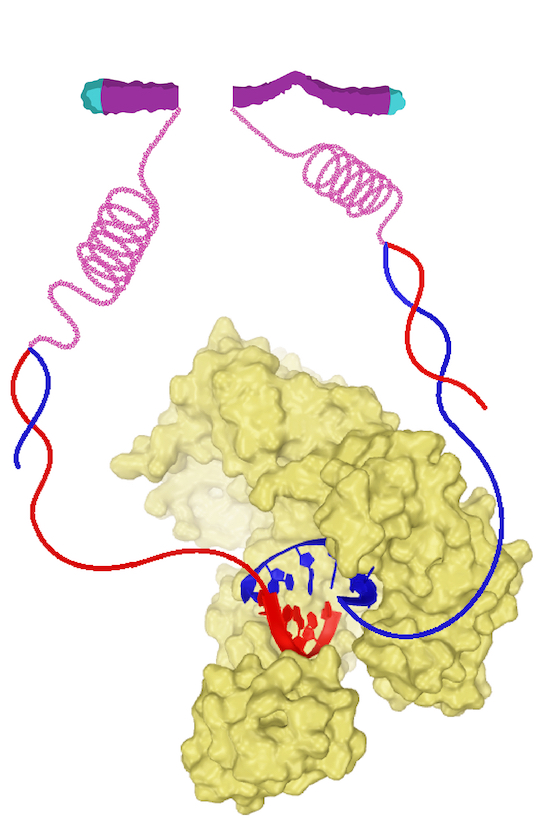
HOUSTON – (Jan. 6, 2023) – Researchers from Rice University and St. Jude Children’s Research Hospital in Memphis, Tennessee, took a close look at one of the ways cells repair broken strands of DNA and discovered details that could help make a particular enzyme a promising target for precision cancer therapy.

Not unlike patching a tire, the job of DNA polymerase theta (aka Pol theta) is to fix double-strand breaks in DNA, bridging the hanging single-stranded ends and catalyzing DNA synthesis across the break, a process known as microhomology-mediated end joining (MMEJ).
MMEJ is complementary to two other processes — homologous recombination and non-homologous end joining — that repair DNA double-strand breaks, but with lower fidelity because Pol theta is prone to mutation, insertion and deletion errors.
But therein lies the advantage: MMEJ needs Pol theta to repair a double strand.

A new study by Rice and St. Jude’s researchers in the journal Nucleic Acids Research reveals for the first time the structural basis of Pol theta-mediated MMEJ, showing how its unique insertion loops help stabilize short DNA binding as it prepares a site for MMEJ repair.
Yang Gao, a Rice assistant professor of biosciences, Ji Sun, an assistant member of the Structural Biology Department at St. Jude, and postdoctoral researchers Chuxuan Li of Rice and Hanwen Zhu of St. Jude led the study.

“When DNA breaks, it’s very dangerous for the cell, which has to fix it right away,” said Gao, a Cancer Prevention and Research Institute of Texas (CPRIT) Scholar in Cancer Research who studies the mechanisms of DNA replication. “One break can kill the cell, and cells don’t want to die, especially cancer cells.
“One of the most usual scenarios is when patients have a BRCA1 or BRCA 2 mutation,” he said. When healthy, the genes express DNA-repair proteins, but mutations can trigger breast cancer. “When a patient has a problem with these genes, they can’t be repaired through the homologous recombination pathway. They have to go to the other pathways.
“Eight years ago people found that when they knock out Pol theta in normal cells, it will not be a problem,” Gao said. “But if the knockout of this protein is in cells with mutant BRCA1 or BRCA2, these deficiencies can be lethal. That’s what makes this a very promising drug target. A Pol theta inhibitor wouldn’t hurt normal cells, only cancer cells.”
He said clinical trials of such treatments are underway based on research by other labs, but the Rice lab’s research adds details about the mechanism.
Li noted that while the experiments in the new paper were on proteins drawn from the Asian sea bass, her work is continuing on the human version.
“I love this project,” she said. “I think there’s so much that can be done specifically for this enzyme, because it’s so unique. I believe more people will be motivated to look into this particular protein.”
Co-authors of the paper are graduate student Shikai Jin and undergraduate Leora Maksoud of Rice and senior scientist Nikhil Jain of St. Jude.
The research was supported by CPRIT (RR190046), the American Cancer Society (RSG-22-082-01-DMC), the National Institutes of Health (HL143037), the American Lebanese Syrian Associated Charities, the Welch Foundation (C-0016) and the National Science Foundation through a grant (2019745) to the Rice-based Center for Theoretical Biological Physics.
- Peer-reviewed paper
-
“Structural basis of DNA polymerase theta mediated DNA end joining” | Nucleic Acids Research | DOI: 10.1093/nar/gkac1201
Chuxuan Li, Hanwen Zhu, Shikai Jin, Leora M. Maksoud, Nikhil Jain, Ji Sun and Yang Gao
- Image downloads
-
https://news-network.rice.edu/news/files/2022/12/0109_DNA-1-web.jpg
CAPTION: The structure of DNA polymerase theta, which serves to fix double-strand breaks in DNA (at top) by bridging the hanging single-stranded ends and catalyzing DNA synthesis across the break. Researchers from Rice University and St. Jude Children’s Research Hospital in Memphis, Tennessee, studied the enzyme’s role in a process known as microhomology-mediated end joining and discovered it could be a promising target for precision cancer therapy. (Credit: Illustration by Chuxuan Li/Gao Lab)https://news-network.rice.edu/news/files/2022/12/0109_DNA-2-web.jpg
CAPTION: Rice University postdoctoral researcher Chuxuan Li views molecules through an FEI Tecnai TF20 cryo-transmission electron microscope, an important tool in her investigation of a DNA-repair enzyme called “Pol theta.” The research could help enhance cancer drug development. (Credit: Gustavo Raskosky/Rice University)https://news-network.rice.edu/news/files/2022/12/0109_DNA-3-WEB.jpg
CAPTION: Rice University bioscientists Yang Gao and Chuxuan Li. (Credit: Gustavo Raskosky/Rice University) - Related stories
-
Rice models moving ‘washers’ that help DNA replicate – Aug. 9, 2022
https://news.rice.edu/news/2022/rice-models-moving-washers-help-dna-replicateCrystal study may resolve DNA mystery – May 9, 2022
https://news.rice.edu/news/2022/crystal-study-may-resolve-dna-mysteryRice lab dives deep for DNA’s secrets – Aug. 27, 2021
https://news.rice.edu/news/2021/rice-lab-dives-deep-dnas-secrets - Links
-
Gao Lab: http://yanggaolab.blogs.rice.edu
Sun Lab: https://www.stjude.org/research/labs/sun-lab.html
Department of BioSciences: https://biosciences.rice.edu
Wiess School of Natural Sciences: https://naturalsciences.rice.edu
- About Rice
-
Located on a 300-acre forested campus in Houston, Rice University is consistently ranked among the nation’s top 20 universities by U.S. News & World Report. Rice has highly respected schools of Architecture, Business, Continuing Studies, Engineering, Humanities, Music, Natural Sciences and Social Sciences and is home to the Baker Institute for Public Policy. With 4,240 undergraduates and 3,972 graduate students, Rice’s undergraduate student-to-faculty ratio is just under 6-to-1. Its residential college system builds close-knit communities and lifelong friendships, just one reason why Rice is ranked No. 1 for lots of race/class interaction and No. 1 for quality of life by the Princeton Review. Rice is also rated as a best value among private universities by Kiplinger’s Personal Finance.














